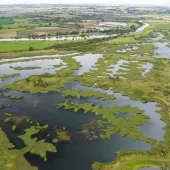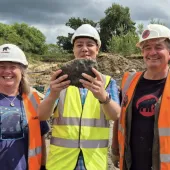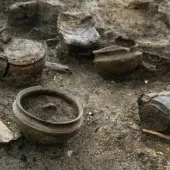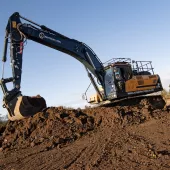Ice Age Hand-axes Found Off English Coast
A remarkable haul of 28 flint hand-axes, dated by archaeologists to be around 100,000 years old, have been unearthed in gravel from a licensed marine aggregate dredging area 13km off Great Yarmouth. The axes show that deep in the Ice Age mammoth hunters roamed across land that is now submerged beneath the North Sea.
The find was made by a Dutch amateur archaeologist, Jan Meulmeester, who regularly searches for mammoth bones and fossils in marine sand and gravel delivered by Hanson to a Dutch wharf at Flushing, south-west Netherlands.
Phil Harding of Wessex Archaeology and Channel 4’s ‘Time Team’ programme is an expert on the Ice Age. He said: ‘These finds are massively important. In the Ice Age the cold conditions meant that water was locked up in the ice caps. The sea level was lower then, so in some places what is now the seabed was dry land. The hand-axes would have been used by hunters in butchering the carcasses of animals like mammoths.
‘Although we don’t yet know their precise date, we can say that these hand-axes are the single most important find of Ice Age material from below the North Sea.’
English Heritage, the Government’s advisory body for heritage, is co-operating with its Dutch counterparts, the National Service for Archaeology, Cultural Landscape and Built Heritage to evaluate the finds. The hand-axes date to the Palaeolithic (or Old Stone Age) but exactly when in that 750,000-year time span is yet to be determined.
Although the hand-axes were discovered in Holland, the gravel came from a licensed marine dredging area in English waters known as Area 240 – some 13km off Great Yarmouth, lying in a water depth of about 25m. Bones and teeth, some of which may be from mammoths, were also recovered along with the axes.
Ian Selby, Hanson’s marine operations and resources director, commented: ‘The hand-axes were collected over a three-month period and this remarkable discovery only came to light in February when Mr Meulmeester, realizing their importance, informed the wharf owners. As we manage our dredging very carefully, we were quickly able to identify the area where the finds came from. As part of our industry’s protocol with English Heritage, we have now moved dredging to another part of the seabed.’
In 2005 the marine aggregates industry, through its trade association, the British Marine Aggregate Producers Association (BMAPA), signed a protocol which aims to protect archaeological remains discovered in English waters as a result of marine sand and gravel extraction.








